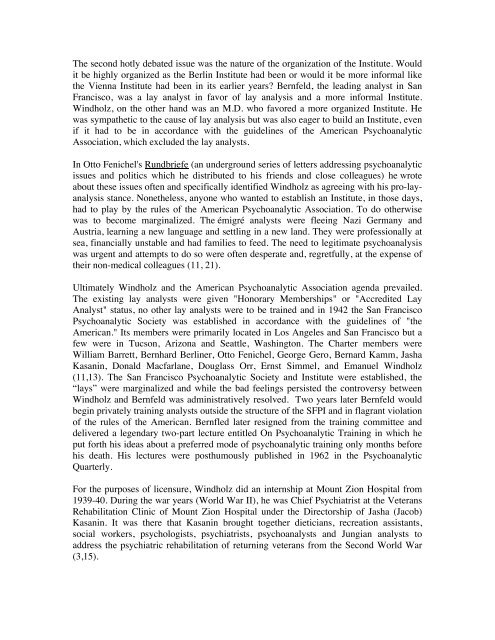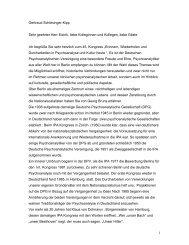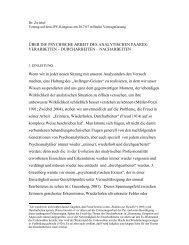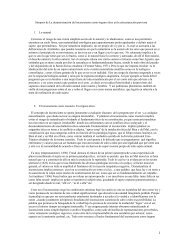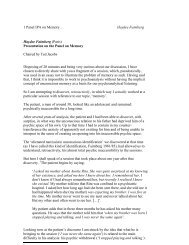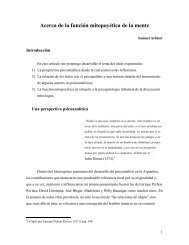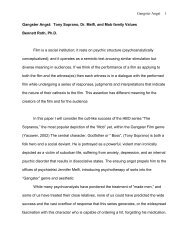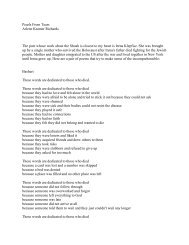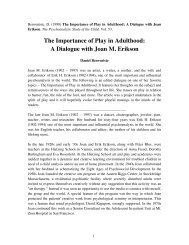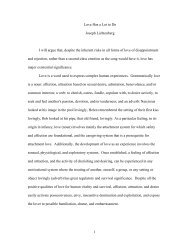Emanuel Windholz: The Institute Builder - International Psychoanalysis
Emanuel Windholz: The Institute Builder - International Psychoanalysis
Emanuel Windholz: The Institute Builder - International Psychoanalysis
You also want an ePaper? Increase the reach of your titles
YUMPU automatically turns print PDFs into web optimized ePapers that Google loves.
<strong>The</strong> second hotly debated issue was the nature of the organization of the <strong>Institute</strong>. Would<br />
it be highly organized as the Berlin <strong>Institute</strong> had been or would it be more informal like<br />
the Vienna <strong>Institute</strong> had been in its earlier years? Bernfeld, the leading analyst in San<br />
Francisco, was a lay analyst in favor of lay analysis and a more informal <strong>Institute</strong>.<br />
<strong>Windholz</strong>, on the other hand was an M.D. who favored a more organized <strong>Institute</strong>. He<br />
was sympathetic to the cause of lay analysis but was also eager to build an <strong>Institute</strong>, even<br />
if it had to be in accordance with the guidelines of the American Psychoanalytic<br />
Association, which excluded the lay analysts.<br />
In Otto Fenichel's Rundbriefe (an underground series of letters addressing psychoanalytic<br />
issues and politics which he distributed to his friends and close colleagues) he wrote<br />
about these issues often and specifically identified <strong>Windholz</strong> as agreeing with his pro-layanalysis<br />
stance. Nonetheless, anyone who wanted to establish an <strong>Institute</strong>, in those days,<br />
had to play by the rules of the American Psychoanalytic Association. To do otherwise<br />
was to become marginalized. <strong>The</strong> émigré analysts were fleeing Nazi Germany and<br />
Austria, learning a new language and settling in a new land. <strong>The</strong>y were professionally at<br />
sea, financially unstable and had families to feed. <strong>The</strong> need to legitimate psychoanalysis<br />
was urgent and attempts to do so were often desperate and, regretfully, at the expense of<br />
their non-medical colleagues (11, 21).<br />
Ultimately <strong>Windholz</strong> and the American Psychoanalytic Association agenda prevailed.<br />
<strong>The</strong> existing lay analysts were given "Honorary Memberships" or "Accredited Lay<br />
Analyst" status, no other lay analysts were to be trained and in 1942 the San Francisco<br />
Psychoanalytic Society was established in accordance with the guidelines of "the<br />
American." Its members were primarily located in Los Angeles and San Francisco but a<br />
few were in Tucson, Arizona and Seattle, Washington. <strong>The</strong> Charter members were<br />
William Barrett, Bernhard Berliner, Otto Fenichel, George Gero, Bernard Kamm, Jasha<br />
Kasanin, Donald Macfarlane, Douglass Orr, Ernst Simmel, and <strong>Emanuel</strong> <strong>Windholz</strong><br />
(11,13). <strong>The</strong> San Francisco Psychoanalytic Society and <strong>Institute</strong> were established, the<br />
“lays” were marginalized and while the bad feelings persisted the controversy between<br />
<strong>Windholz</strong> and Bernfeld was administratively resolved. Two years later Bernfeld would<br />
begin privately training analysts outside the structure of the SFPI and in flagrant violation<br />
of the rules of the American. Bernfled later resigned from the training committee and<br />
delivered a legendary two-part lecture entitled On Psychoanalytic Training in which he<br />
put forth his ideas about a preferred mode of psychoanalytic training only months before<br />
his death. His lectures were posthumously published in 1962 in the Psychoanalytic<br />
Quarterly.<br />
For the purposes of licensure, <strong>Windholz</strong> did an internship at Mount Zion Hospital from<br />
1939-40. During the war years (World War II), he was Chief Psychiatrist at the Veterans<br />
Rehabilitation Clinic of Mount Zion Hospital under the Directorship of Jasha (Jacob)<br />
Kasanin. It was there that Kasanin brought together dieticians, recreation assistants,<br />
social workers, psychologists, psychiatrists, psychoanalysts and Jungian analysts to<br />
address the psychiatric rehabilitation of returning veterans from the Second World War<br />
(3,15).


